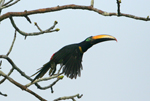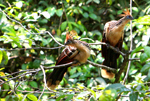
Collared puffbird (Bucco capensis) in Yasuni National Park in the Ecuadorian Amazon. Photo by Jeremy Hance
In late 2010, mongabay.com reporter Jeremy Hance traveled to Yasuni National Park, arguably the most biodiverse place on the planet and home to a unique initiative to save a rainforest by asking the international community to pay to keep oil in the ground.
Researchers have found more tree species (655 to be exact) in a single hectare in Yasuni National Park than in all of the U.S. and Canada combined. Yasuni also contains the highest biodiversity of reptiles and amphibians in the world with 271 species. But insects trump them all: entomologist Terry Erwin has estimated that a single hectare of rainforest in Yasuni may contain as many as 100,000 unique insect species. If true this would mean Yasuni has the highest per unit area of biodiversity in the world for any taxa, plant or animal.
But Yasuni National Park is also home to oil. Some of that oil is already being tapped, but a remote bloc of the park, known as the Ishpingo-Tambococha-Tiputinin (ITT) bloc, sits on an estimated 846 million barrels of oil. In most countries, such a discovery would signal the immediate arrival of oil companies ready to exploit the fossil fuel. But Ecuador has come up with an intriguing, although controversial, idea. With the help of the UN, the country has proposed that if the international community pays $3.6 billion (or about half the worth of the oil) into a trust fund then it will forgo exploitation of the Yasuni-ITT oil fields. The trust fund would provide monies for renewable energy projects, as well as social programs, research initiatives, conservation, and reforestation projects.
Ecuador argues that leaving the oil in the ground will keep 410 million tons of CO2 out of the atmosphere, preserve some of the world’s richest biodiversity, and safeguard indigenous tribes who call Yasuni home.
But the initiative has had trouble getting off the ground. Given its originality, the initiative has been plagued with questions, most important of which is can Ecuador convince investors it will never drill in the park, even if the government changes hands? Critics have called the program a “ransom” and have rightly pointed out that given that the oil fields are in a national park and apart of a UNESCO World Biosphere Reserve, the area should already simply be off limits to oil companies. But across the developing world and even in parts of the industrial world, such laws have rarely held back the drum beat of oil.
Currently the project remains alive after Ecuador raised $116 million last year, but they have a long way to go to raise the remaining $3.48 billion.
Proponents of the project argue that in an age of climate change and looming mass extinction, the Yasuni-ITT initiative may provide a unique way forward: keeping oil in the ground, funding renewable energy, and safeguarding one of the most beautiful places on Earth.
Pictures of Yasuni

Sparkling violetear hummingbird (Colibri coruscans) in Quito, Ecuador.

Many-banded aracari (Pteroglossus pluricinctus) in Yasuni National Park in the Ecuadorian Amazon

Wild female Brazilian tapir (Tapirus terrestris), which was raised by an indigenous tribe after her mother was hunted for food, periodically seeks out humans

Collared puffbird (Bucco capensis) in Yasuni National Park in the Ecuadorian Amazon

Black caiman (Melanosuchus niger) with fly in an ox-bow lake in Yasuni National Park in the Ecuadorian Amazon

Settlement and deforestation along Napo River in Ecuadorian Amazon

Detail of sparkling violetear hummingbird (Colibri coruscans) in Quito, Ecuador.

Sparkling violetear hummingbird (Colibri coruscans) in Quito, Ecuador.

Juvenile green anaconda (Eunectes murinus) in Yasuni National Park in the Ecuadorian Amazon

Millipede in Yasuni National Park in the Ecuadorian Amazon

Many-banded aracari (Pteroglossus pluricinctus) in Yasuni National Park in the Ecuadorian Amazon

Oropendola (species?) in Yasuni National Park in the Ecuadorian Amazon

Oropendola (species?) in Yasuni National Park in the Ecuadorian Amazon
|

Poison dart frog (Ameerega bilinguis) in Yasuni National Park in the Ecuadorian Amazon

Tarantula laying eggs at night in Yasuni National Park in the Ecuadorian Amazon

Rufescent tiger heron (Tigrisoma lineatum) in Yasuni National Park in the Ecuadorian Amazon

Wild female Brazilian tapir (Tapirus terrestris), which was raised by an indigenous tribe after her mother was hunted for food, periodically seeks out humans

Red-capped cardinal (Paroaria gularis) feeding juvenile in Yasuni National Park in the Ecuadorian Amazon

Red-capped cardinal (Paroaria gularis) in Yasuni National Park in the Ecuadorian Amazon

Green insect in Yasuni National Park in the Ecuadorian Amazon

Guide picking up a bom jardim toad (Rhinella dapsilis) with a leaf in Yasuni National Park in the Ecuadorian Amazon

Flowers in Yasuni National Park in the Ecuadorian Amazon

Ferocious looking insect in Yasuni National Park in the Ecuadorian Amazon

Camouflaged moth in Yasuni National Park in the Ecuadorian Amazon

Bess beetle in the Passalidae family in Yasuni National Park in the Ecuadorian Amazon

Golden-mantled tamarin (Saguinus tripartitus) raiding a banana garden in Yasuni National Park in the Ecuadorian Amazon
|

Guide picking up a bom jardim toad (Rhinella dapsilis) with a leaf in Yasuni National Park in the Ecuadorian Amazon

Collared puffbird (Bucco capensis) in Yasuni National Park in the Ecuadorian Amazon

Eye of a black caiman (Melanosuchus niger) in an ox-bow lake in Yasuni National Park in the Ecuadorian Amazon

Blue, black, and orange butterfly in Yasuni National Park in the Ecuadorian Amazon

Morpho butterfly in Yasuni National Park in the Ecuadorian Amazon

Huaorani guide with machete in Yasuni National Park in the Ecuadorian Amazon

Wild female Brazilian tapir (Tapirus terrestris), which was raised by an indigenous tribe after her mother was hunted for food, periodically seeks out humans

Close-up of wild female Brazilian tapir (Tapirus terrestris), which was raised by an indigenous tribe after her mother was hunted for food, periodically seeks out humans

Juvenile South American common toad (Rhinella margaritifer) in Yasuni National Park in the Ecuadorian Amazon

Large snail in Yasuni National Park in the Ecuadorian Amazon

Flowers in Yasuni National Park in the Ecuadorian Amazon

Hoatzins (Opisthocomus hoazin) in Yasuni National Park in the Ecuadorian Amazon

Bat hanging out on ox-bow lake in Yasuni National Park in the Ecuadorian Amazon

Butterfly rests on camera in Yasuni National Park in the Ecuadorian Amazon
|
More Pictures of Ecuador by Jeremy Hance.
Related articles








































